The dynamic nature of the modern world and everything that it comprises of has meant that people have very little time to perform menial tasks. As a consequence of this, people are actively looking for solutions that could simplify tasks that require minimal effort but a lot of time.
The emergence of on-demand service providers can be regarded as one of the greatest upshots of this development. These businesses assist you in performing regular, day-to-day activities, or rather, just do it themselves in exchange for a small fee. And considering the utility they offer, most consumers are more than happy to bear the extra costs. This particular consumer attitude has ensured that the number of on-demand service providers is inflating with each passing day. And easily the most popular among them, the ‘flag bearer’, is Uber.
Uber and other so-called ride-hailing apps have been the biggest beneficiaries of this new world trend that on-demand services have become. Their greatest USP is the ease with which they can be operated. Just click a button on your smartphone (the modern day magic wand!) and swoosh! You have a taxi waiting at your doorstep! With their functionality now being a known secret and the irreversible nature of time constraints that plague people all over the world, a bright future lies ahead for on-demand taxi startups.
For opportunistic, forward-thinking entrepreneurs, the lucrativeness of creating an app like Uber would unfailingly prompt questions like:
How to build an app like Uber?
How much does the Uber app cost?
Who can build an app like Uber?
What technology is required to build an app like Uber?
And so on...
Needless to say, there is a lot of technological nous that comes into play here.
If you’re looking for a taxi app development company with extensive experience in building ride-hailing solutions, understanding the complexities of the platform is crucial. From initial research and design to app development and testing, choosing the right development partner will ensure the success of your project.
Just consider the points about to be discussed here and you may well have a wholesome guide that would explain just how to create an app like Uber.
How Uber Works?
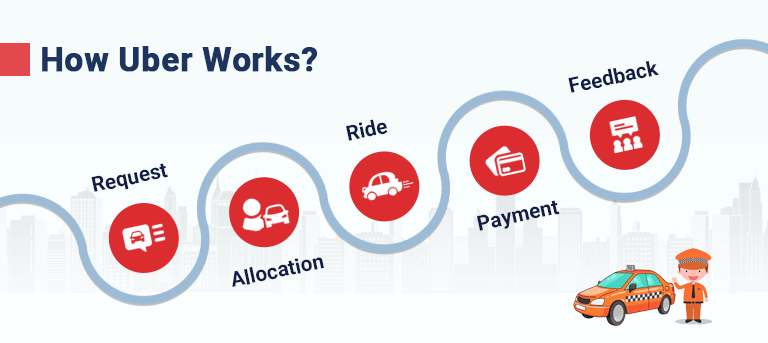
The most important thing you need to understand before you look for answers to ‘how to make an app like Uber?’ and ‘how much does it cost to build an app like Uber?’, is the way a taxi-hailing app like Uber works.
Uber is essentially a digital marketplace that connects passengers with drivers. It establishes and completes that connection in a few simple steps.
- Request
The customer sends in a request for a cab through the app along with the destination and the same is relayed to the driver nearest to his location.
- Allocation/Matching
The driver has the option of accepting or rejecting the fare. If the first contacted driver refutes the ride, the ride request is sent to the next nearest driver.
- Ride
The driver arrives at the pickup point and ferries the customer to his requested destination.
- Payment
Upon completion of the ride, the customer pays the requisite fare, an estimate of which is provided to him before the journey begins.
- Rating & Feedback
The customer then rates the driver based on his overall ride experience.
In Depth: Uber's Business Model Explained
The Complete Ecosystem - Passenger, Driver & Admin
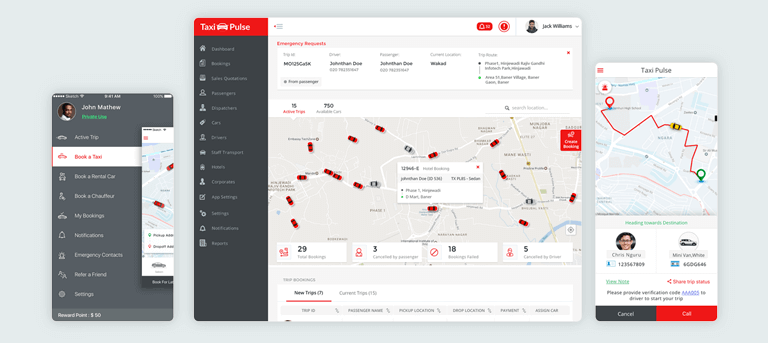
Like for any digital marketplace, a ride-hailing platform’s core function is to connect the consumer (passengers) with the supplier (drivers). That function needs to be performed through 2 separate but connected mobile apps, one each for the driver and the passenger, and the all-important admin panel (the central hub that binds them). Both apps have distinct features that combine to make the platform what it is. Listed below are some of the most essential features for each component that are imperative for developing a taxi-hailing platform.
Passenger App - Basic Features
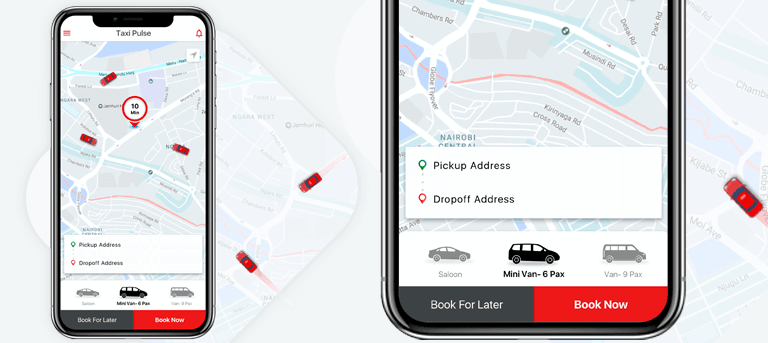
- Registration/Login
First-time users need to register on the app through their email or social media accounts. Users need to login to the app before they can use it.
- Booking Interface
Users feed in their journey details including their destination through the booking interface. They can pick the ride option/vehicle they want to use for the trip.
- Fare Estimates
This feature provides customers with an approximate fare amount they can expect to pay before they embark on their journey. This allows users to determine if they want to proceed with the booking or not.
- Real-time Tracking & ETA
This feature allows users to track their taxi's current location at any given point in time. They can thus determine the time it will take for the driver to pick them up.
- Reviews & Ratings
Passengers have the option of rating their ride experience at the end of every trip.
- Payments
Upon completion of the ride, a passenger receives an auto-generated payment slip to make the payment in the app. An invoice for the same is raised and mailed to the customer's registered email id. Frequent users can store their card or electronic wallet details on their app account to accelerate the payment process.
- Booking History
This particular feature provides customers with all details pertaining to their previous trips.
Driver App - Basic Features
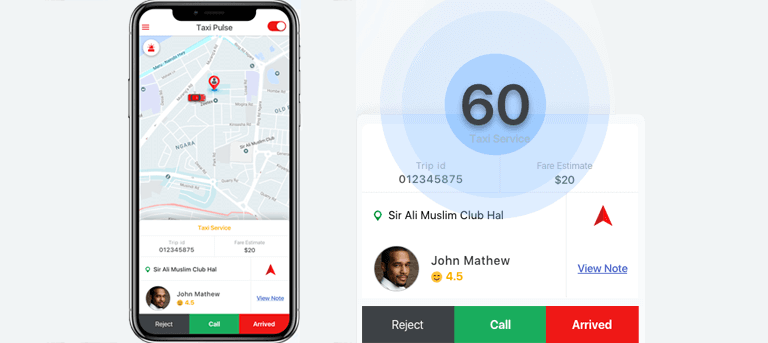
- Real-time Requests
When a passenger makes a request, it gets relayed to the most optimal driver nearby with a limited time-frame to accept or reject the request.
- Trip Details
Drivers get the passenger trip information to make a seamless pickup and drop, building customer trust.
- Navigation
Live traffic updates, real-time tracking, alternative routes for a destination, etc are all provided to the drivers through the navigation feature which links the driver app with a navigation service like Google Maps.
- Availability Button
Drivers can mark themselves online or offline anytime and stay flexible.
- Rate Customer
Drivers also get the option to rate their rides and flag bad customers and behavior.
- Driver Dashboard
Drivers get useful stats and insights on their trips, performance, and feedback.
- Track Earnings
Drivers can track their daily earnings, view pending payments and get useful insights on their performance right from the taxi driver app.
If you want to introduce more specialized services like bike taxi app development, the functionality of the app will include additional features like bike-specific routes, safety checks for two-wheeled vehicles, and options for riders to choose between different bike types.
Passenger & Driver Apps - Some Advanced Features to Consider
- Surge Pricing
Algorithmically controlled dynamic pricing to handle demand and supply mismatch. - Number Masking
Keep passenger phone numbers hidden during calls for better privacy. - Scheduling Rides
Scheduled booking option can be provided to ensure ride availability on a particular day and time. The riders can book for a later date or at a later time on the same day by setting up a pickup time and date and book a ride as they usually do. - In-app Messaging
Both customers and drivers can contact each other through this feature to confirm pickup location, arrival time, etc. - Bill Splitting
This feature enables passengers heading to destinations that lie on the same route to share the ride and split the bill. - Sharing Location
Real-time trip status and ETA sharing is helpful for riders to share with their families, friends and those they’re about to meet, avoiding panicked phone calls and long texts. This can be sent to multiple people, with just one tap. - Web App
Allow your passengers to book from the mobile web without needing an app. - Book For Others
You could allow your app users to request rides for someone else by providing their phone number, the pickup and drop point. The rider will get the driver location tracking link and the driver’s contact details via a text message. - Demand Map
The heat map helps drivers know when a particular location is at its busiest and also when the demand for a taxi is at its lowest in that region. A real-time driving map assists them in making a more informed decision for choosing the location they wish to head towards for a pickup. - Driver Destinations
This feature enables drivers to add their most frequently used routes, to their home for example. Once these routes are set, the drivers receive ride requests along them if they are traveling by those routes. - RTL Language Support
Make your app available in RTL language to cater to a targeted market.
The Crucial Admin Panel and Its Importance

The admin panel is the central hub for any ride-hailing platform like Uber. It is a web application which controls all the platform activities. It offers a comprehensive overview of each and every process, bookings management, helps drivers choose the most convenient routes, and accumulates customer data to improve service quality. In the absence of a robust admin panel, managing daily operations and processes can become a troublesome task; particularly when operations are scaled.
Other On-demand Taxi Apps That Have Made it Big!
Besides Uber, many other on-demand taxi apps have found tremendous success in this business and have carved out a niche for themselves.
- Lyft
There isn’t a lot to differentiate between the features and business model of Lyft and Uber; so much so that you could almost look at it as a model answer to the ‘how to build an app like Uber’ question. The only point of differentiation is that Lyft primarily plies its trade in the USA, while Uber is active in about 80 countries around the world. - DiDi
If you could drive Uber off the streets, then you are really doing a lot of things very well! And that’s just what ride-sharing app DiDi did in China. With a 450 million strong customer base in China, DiDi left Uber with no option but to cease operations. And the company is now looking to make a foray into overseas markets, thereby instigating a lot of industry experts to pitch it as Uber’s greatest challenge in the years to come. - Ola
An Indian origin on-demand taxi app, Ola is Uber’s fiercest rival and the leading ride-hailing app service in India. The company has recently ventured into foreign territories by kicking off its operations in Australia. - Grab
With over 50 million downloads on Google Play Store, Grab is one of South-East Asia’s most popular ride-sharing and taxi app. The company also offers carpooling and shuttle services to its users. - Careem
Known as the ‘Uber of the Middle East’, this Dubai-based transportation network company is the go-to taxi app for users in the Arab World. Having only been 6 years in existence, the company has still managed to branch its operations to Northern Africa and South Asia.
How Much Does it Cost to Build an App Like Uber?
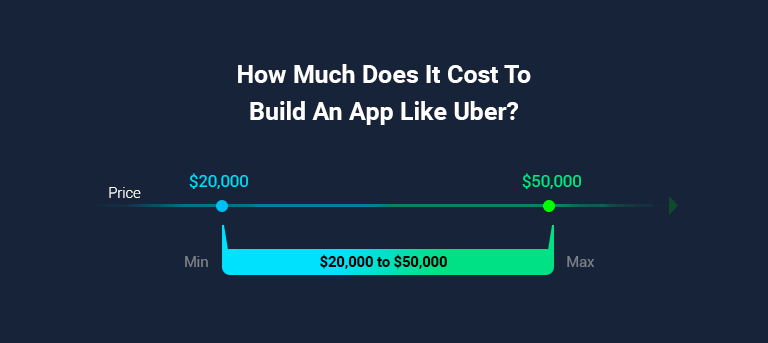
Now that you are through with how to create an app like Uber and the basic and advanced features that need to be incorporated into the apps, it’s time you consider how much does it cost to develop an app like Uber. The cost incurred in developing the entire app platform is complex and involves multiple factors.
Some of the critical factors dictating the cost of building a ride-hailing platform like Uber are:
The number and type of platforms you wish to support for both the passenger and driver apps (iOS, Android, Web).
The number of features you want to integrate within both the apps.
Whether you require a market-ready app or just an MVP.
How user-friendly you want the UI to be.
The iterations that have to be accommodated post-launch.
As per our experience shipping 20+ Uber like white label taxi app solutions till date, the cost of building an app like Uber can lie anywhere between $20,000 to $50,000 depending on the sophistication of the platform. You can also quickly get started with a monthly subscription option.
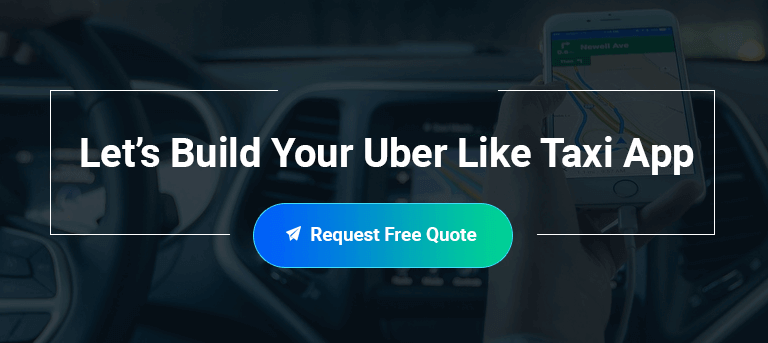




 July 19, 2018
July 19, 2018


